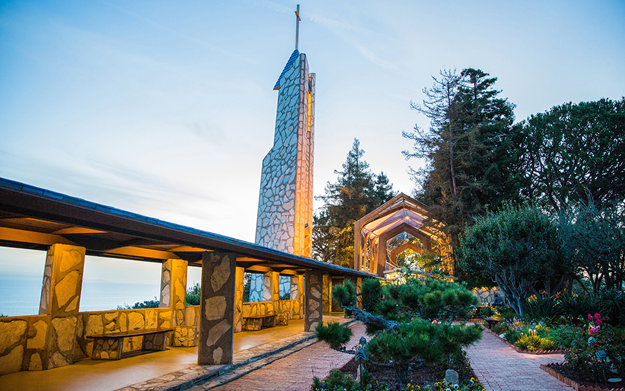DEDICATED 71 YEARS AGO NOW….May 13, 1951 Wayfarer's Chapel, Architecture and History By Contributor and Writer Philip Wahba
DEDICATED 71 YEARS AGO NOW….May 13, 1951 Wayfarer's Chapel
By Contributor and Writer Philip Wahba
DEDICATED 71 YEARS AGO NOW….May 13, 1951 Wayfarer's Chapel
Frank Lloyd Wright Jr. (1890-1978) was a well known American architect. He changed his name to Lloyd Wright to create his own individual identity. His projects were mainly featured and focused in Los Angeles and over Southern California. His most notable work was the Hollywood Bowl shell from 1926-1928. His other most notable being the Wayfarers Chapel. He was originally a landscape architect and designed the grounds of the chapel, which featured many landscape features such as water fountains and gardens.
The Wayfarers Chapel, also known as the “glass church” on Palos Verdes Drive South,was designed by Lloyd Wright in 1949 and the building was later completed in 1951. Lloyd Wright was the son of famous architect Frank Lloyd Wright. This gorgeous chapel sits atop a hill overlooking the Pacific Ocean. The project is said to have cost $25,000, and the building itself is only 28 feet high and 27 feet long. The land was donated by Narcissus Cox Vanderlip.
That particular site was selected along the picturesque coast to construct it as a memorial to Emanuel Swedenborg, the 18th century Swedish philosopher and mystic. Swedenborg wrote 30 volumes of religious work, which probed the nature of reality and espoused tolerance and holistic living.
Lloyd used organic architecture to incorporate plants and natural trees around the site forming a natural sanctuary within the chapel. It incorporated nature and architectural ingenuity. The chapel was made up of wood and glass exposing the trees and natural sunlight above and around enclosing the natural sanctuary. Local Palos Verdes stone was also incorporated into the chapel and design. The trees planted over 50 years ago have matured and make up somewhat of a beautiful wall surrounding the chapel.
The Wayfarers Chapel, located very close to the famous Portuguese Bend landslide that has been moving and sliding for many years, has no records of having any foundation or land movement problems, unlike other structures in the local vicinity. Although, to protect Wayfarers Chapel, the city pumped water out from underneath the land around it for many years to ensure its stability. In fact, the visitors center was declared a complete loss due to land movement. In 2001, Eric Wright, the next generation of Wright family designers, stepped forward to rebuild the visitors center.
The Wayfarers Chapel was added in 2005 to the National Register of Historic Places. It is world famous and attracts many tourists. The chapel is a popular destination for weddings as well. It is estimated that about 800 weddings per year are performed.
Wayfarers was dedicated to travelers in need of spiritual nourishment and has no permanent congregation. It truly is a beauty for all to enjoy.
Sources
https://www.wayfarerschapel.org/about/history/
https://www.laconservancy.org/locations/wayfarers-chapel
Images courtesy of www.wayfarerschapel.org
Philip Wahba graduated from the University of Oregon. He is a graduate of Palos Verdes High School. Growing up on the Palos Verdes Peninsula, he was always fascinated with the local history. Coming home has given him a new perspective and interest in the South Bay, past and present. His interests include local real estate and architecture. In his free time, he enjoys watching and cheering for the Los Angeles sports teams, especially the Dodgers.





